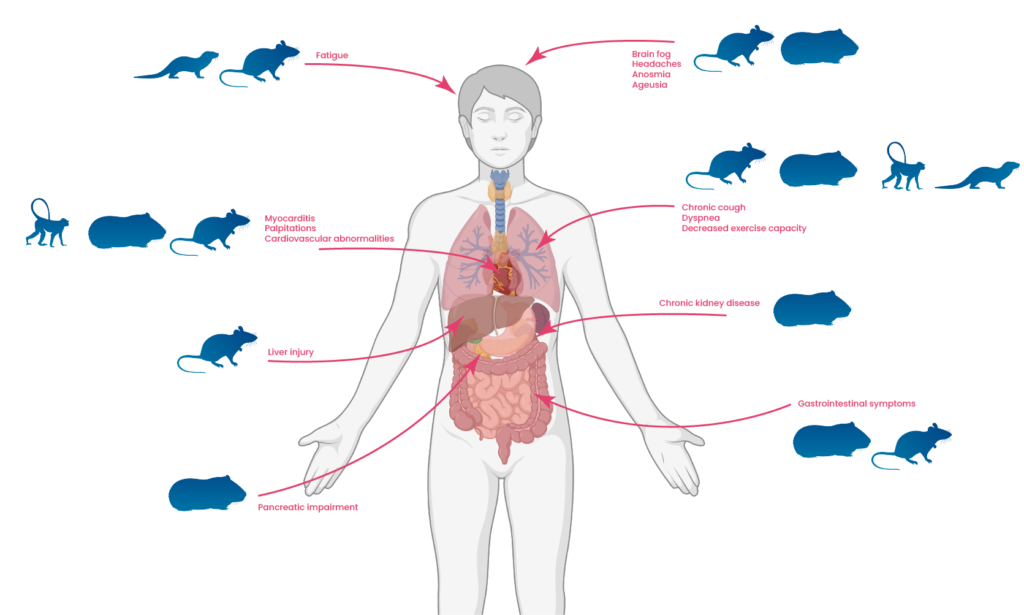


What is long COVID?
Long COVID, also referred to as post-acute sequelae of COVID-19 (PASC), is a term used to describe the multisystemic symptoms and complications that some people experience after a severe SARS-CoV-2 infection. While most people recover from COVID-19 within a few weeks, others continue to experience symptoms for months or even longer. It is estimated that around 10% of infected individuals undergo long COVID, which represents at least 65 million individuals worldwide, with the incidence being higher in hospitalized people (around 50-70% of the cases). The exact causes of long COVID are still not fully understood, and there is currently no cure or treatment for this condition. Here, we explore the pathophysiology of long COVID and the preclinical animal models that can be used to better understand this condition and test candidate treatments.
Symptoms and underlying causes of long COVID
Long COVID can affect multiple organ systems, including the respiratory, cardiovascular, neurological, and gastrointestinal systems. Some of the most common symptoms of long COVID include fatigue, shortness of breath, chest pain, palpitations, abdominal pain, nausea, cognitive impairment, memory loss, tinnitus, and reproductive system dysfunction.
The causes of such symptoms are still under investigation, and are suspected to be multiple and potentially overlapping. It has been suggested that contributors to the pathogenesis may include:
- maintenance of long-term SARS-CoV-2 reservoirs in the tissues such as lungs, heart or brain;
- immune system dysregulation including autoimmunity; impact on the microbiota;
- dysregulation of coagulation; and neuroinflammation.
Persistent infection may lead to chronic inflammation and damage to tissues, resulting in long-term symptoms.
It is important to note that the large majority of long COVID patients were not hospitalized for their initial SARS-CoV-2 infection, leading to specific difficulties for the long-term monitoring of such “mild COVID-19” patients. There are many challenges related to diagnosing and testing issues for long COVID, such as a certain lack of knowledge of the non-respiratory sequelae of COVID-19 among health professionals, and gaps in the identification and follow up of this specific group of patients.
Preclinical Models of long COVID
Considering the current partial understanding of this complex disease, experimental exploration of the pathophysiolgy of long COVID is necessary. Better mimicking the symptoms in laboratory models is crucial to the preclinical development of effective therapeutic interventions.
Soon after the onset of the SARS-CoV-2 pandemic, and based on previous work done at the time of the SARS-CoV outbreak, major efforts were initiated to provide access to a variety of laboratory animal models, including (genetically modified) mouse models, golden Syrian hamsters, ferrets and non-human primates. Neither of these models fully recapitulate all of the aspects of the human disease, as each species tends to reproducibly develop a certain severity of symptoms. In other words, the heterogeneity in symptoms and disease severity observed in humans cannot be observed in one given animal model. Still, these animal models usually show viral presence in tissues outside airways, for instance in the heart, the gastrointestinal tract, kidneys and the central nervous system. Furthermore, long term damage in lungs and other tissues, in particular heart, kidneys and brain, have been reported for instance in hamsters. Such damage could be a consequence of local viral replication or excessive local immune responses. Based on this long term and multiorgan disease profile, such experimental models are attractive for the study of long COVID. Still, each of the available species may more suitably recapitulate only certain aspects of long COVID (Figure 1).

Figure 1. Animals models for specific aspects of long COVID.
Conclusion
Long COVID is a complex mutlisystemic condition still poorly understood, significantly impacting the quality of life of the affected individuals. Deciphering long COVID pathophysiology is crucial to develop effective treatments for this condition. Preclinical models are essential tools for the understanding of the mechanisms underlying long COVID and testing potential treatments, and careful selection of the optimal model is required depending on the research question.
About the author
This article was written by Nicolas Legrand, PhD. In his current role at Oncodesign Services, Nicolas is Head Of Translational Pharmacology Department and is involved in inflammatory, auto-immune and infectious diseases R&D programs.
-
References
Davis HE et al. Long COVID: major findings, mechanisms and recommendations. Nat Rev Microbiol. (2023), 21:133.
https://pubmed.ncbi.nlm.nih.gov/36639608/
Frere JJ et al. SARS-CoV-2 infection in hamsters and humans results in lasting and unique systemic perturbations after recovery. Sci Transl Med. (2022), 14:eabq3059.
https://pubmed.ncbi.nlm.nih.gov/35857629/
Jansen EB et al. After the virus has cleared – Can preclinical models be employed for long COVID research? PLoS Pathog. (2022), 18:e1010741.
https://pubmed.ncbi.nlm.nih.gov/36070309/
Käufer C et al. Microgliosis and neuronal proteinopathy in brain persist beyond viral clearance in SARS-CoV-2 hamster model. EBioMedicine (2022), 79:103999.
https://pubmed.ncbi.nlm.nih.gov/35439679/
Munoz-Fontela C. et al. Animals models for COVID-19. Nature (2020), 586:509.
https://pubmed.ncbi.nlm.nih.gov/32967005/
Part of Figure 1 was created with BioRender.com
